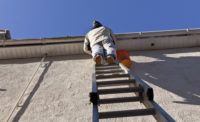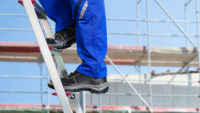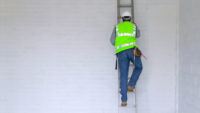2019 top standards- OSHA Most Frequently Violated Standards
OSHA ladders standard
Ladders (1926.1053)

OSHA’s ladders standard for construction was the sixth-most-frequently cited agency standard in FY 2018.
Enforcement citations FY 2018: 2,376
Number of inspections: 2,010
Proposed penalties: $5,536,382
Most frequently cited industries
- Construction
- Wholesale trade
- Manufacturing
- Waste management and remediation
- Real estate and rental and leasing
- Retail trade
- Public administration
Enforcement case study
Jasper Contractors, Kennesaw, Georgia - $375,715
Jasper Contractors chose to negotiate a settlement with OSHA after the agency hit the company with two fines – $239,007 (reduced to $143,404) for violations at one of the company's roofing projects in Orlando and $136,708 (reduced to $82,025) for a project in nearby Kissimmee, Florida. OSHA claimed that Jasper committed violations in regard to ladder safety and fall protection, as well as eye and face protection
OSHA issued Jasper a total of two willful, two serious and one repeat violation, the last one likely based on previous run-ins with agency investigators. OSHA cited Jasper previously for many of the same violations, including fall protection hazards, in April, 2016.
Background
Factors contributing to falls from ladders include haste, sudden movement, lack of attention, the condition of the ladder (worn or damaged), the user's age or physical condition, or both, and the user's footwear.
Hazard protection
Safety tips according to the American Ladder Association:
- If you feel tired or dizzy, or are prone to losing your balance, stay off the ladder.
- Do not use ladders in high winds or storms.
- Wear clean slip-resistant shoes.
- Before using a ladder, inspect it to confirm it is in good working condition.
- When the ladder is set-up for use, it must be placed on firm level ground and without any type of slippery condition present at either the base or top support points.
- Only one person at a time is permitted on a ladder unless the ladder is specifically designed for more than one climber (such as a trestle ladder).
- Ladders must not be placed in front of closed doors that can open toward the ladder. The door must be blocked open, locked, or guarded.
- Read the safety information labels on the ladder.
The three-point contact rule: When climbing a ladder, it is safest to utilize Three Points-of-Contact because it minimizes the chances of slipping and falling from the ladder. At all times during ascent, descent, and working, the climber must face the ladder and have two hands and one foot, or two feet and one hand in contact with the ladder steps, rungs and/or side rails.
Key ladder standard takeaways
The following requirements apply to all ladders, including job-made ladders.
- Each self-supporting portable ladder: Must support at least four times the maximum intended load, except that each extra-heavy-duty type 1A metal or plastic ladder shall sustain at least 3.3 times the maximum intended load.
- Each portable ladder that is not self-supporting: Must support at least four times the maximum intended load, except that each extra-heavy-duty type 1A metal or plastic ladders shall sustain at least 3.3 times the maximum intended load.
- Each fixed ladder: Must support at least two loads of 250 pounds (114 kg) each, concentrated between any two consecutive attachments (the number and position of additional concentrated loads of 250 pounds (114 kg) each, determined from anticipated usage of the ladder, shall also be included), plus anticipated loads caused by ice buildup, winds, rigging, and impact loads resulting from the use of ladder safety devices. Each step or rung shall be capable of supporting a single concentrated load of at least 250 pounds (114 kg) applied in the middle of the step or rung.
- Ladder rungs, cleats, and steps shall be parallel, level, and uniformly spaced when the ladder is in position for use.
- The rungs of individual-rung/step ladders shall be shaped such that employees' feet cannot slide off the end of the rungs.
- Ladders shall not be tied or fastened together to provide longer sections unless they are specifically designed for such use.
- Ladder components shall be surfaced so as to prevent injury to an employee from punctures or lacerations, and to prevent snagging of clothing.
- Wood ladders shall not be coated with any opaque covering, except for identification or warning labels which may be placed on one face only of a side rail.
- Fixed ladders shall be provided with cages, wells, ladder safety devices, or self-retracting lifelines where the length of climb is less than 24 feet (7.3 m) but the top of the ladder is at a distance greater than 24 feet (7.3 m) above lower levels.
- When portable ladders are used for access to an upper landing surface, the ladder side rails shall extend at least 3 feet (.9 m) above the upper landing surface to which the ladder is used to gain access; or, when such an extension is not possible because of the ladder's length, then the ladder shall be secured at its top to a rigid support that will not deflect, and a grasping device, such as a grabrail, shall be provided to assist employees in mounting and dismounting the ladder. In no case shall the extension be such that ladder deflection under a load would, by itself, cause the ladder to slip off its support.
- Ladders shall be maintained free of oil, grease, and other slipping hazards.
- Ladders shall not be loaded beyond the maximum intended load for which they were built, nor beyond their manufacturer's rated capacity.
- Ladders shall be used only for the purpose for which they were designed.
- Non-self-supporting ladders shall be used at an angle such that the horizontal distance from the top support to the foot of the ladder is approximately one-quarter of the working length of the ladder (the distance along the ladder between the foot and the top support).
- Wood job-made ladders with spliced side rails shall be used at an angle such that the horizontal distance is one-eighth the working length of the ladder.
- Fixed ladders shall be used at a pitch no greater than 90 degrees from the horizontal, as measured to the back side of the ladder.
- Ladders shall be used only on stable and level surfaces unless secured to prevent accidental displacement.
- Ladders shall not be moved, shifted, or extended while occupied.
- Ladders shall be inspected by a competent person for visible defects on a periodic basis and after any occurrence that could affect their safe use.
- When ascending or descending a ladder, the user shall face the ladder.
- Each employee shall use at least one hand to grasp the ladder when progressing up and/or down the ladder.
- An employee shall not carry any object or load that could cause the employee to lose balance and fall.
Compliance resources
Ladder Safety: Reducing Falls in Construction: Safe Use of Extension Ladders Fact Sheet (OSHA FS-3660 - 2013)
Ladder Safety: Reducing Falls in Construction: Safe Use of Job-made Wooden Ladders Fact Sheet (OSHA FS-3661 - 2013)
Ladder Safety: Reducing Falls in Construction: Safe Use of Stepladders Fact Sheet (OSHA FS-3662 - 2013)
Looking for a reprint of this article?
From high-res PDFs to custom plaques, order your copy today!








